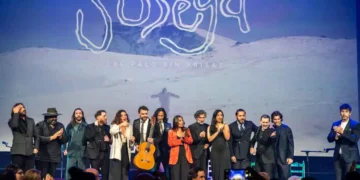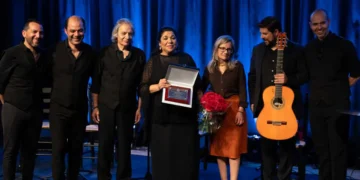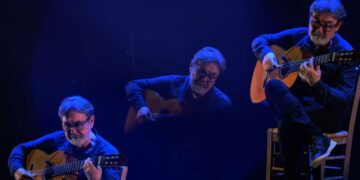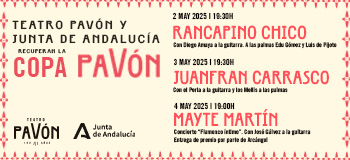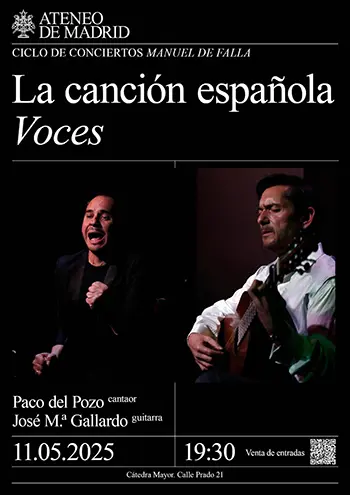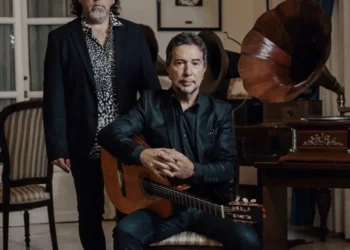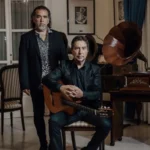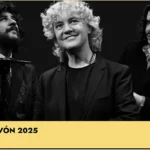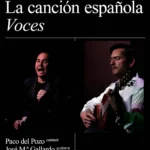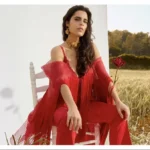|
Text & photos: Estela
Zatania
Dance and choreography: Rocío Molina. Guest artists:
Lola Greco, Manolo Monteagudo. Special collaboration: Pasión
Vega. Piano: Rafael Marinelli. Guitar: Juan Recuña, Jesús
Torres. Cante: Antonio Campos, Antonio “El Pulga”. Percussion:
Sergio Martínez. Palmas: Luis Cantarote, Carlos Grilo. Staging:
Pepa Gamboa. Original idea, music: Juan Carlos Romero.
Seated in the lovely Teatro del Carmen in the lovely town of Vélez-Málaga,
thirty kilometers from the capital of the Costa del Sol, while waiting
for the curtain to go up, I read the program notes to discover that
the work I am about to see is based on concepts from Nietzsche,
Borges, Szymborska and Zorn, and seeks to “free us of stereotypes”.
So I pass the time thinking about what a stereotype is, and how
it comes into being. The topic is not entirely devoid of relevance
since an entire generation of flamenco artists has felt the need
to reject what it considers stereotypes, while it’s not entirely
clear how they are to be defined.
Before a stereotype comes into being, there is a truth –
a reality so blatant and undeniable that no divergence of opinion
is possible. In time, successive generations cling to that truth
without questioning it, and “the truth” runs the risk
of becoming deformed since no reality checks are being made. The
art of flamenco is now going through a process of reassessment and
stock-taking in which every one of us, artists, critics and consumers,
are obliged to find our own personal truth, the frontier that separates
that which is worthwhile and valid, from the merely novel, mediocre
or cheap.
That bit of introspection is to the point because Rocío
Molina is an exceptionally gifted and intelligent young dancer who
with “El eterno retorno” which premiered as part of
the Málaga en Flamenco festival, has set her frontier with
imagination and dedication, and now we must pass judgement on the
final result, brutal though that may sound. A quick flashback….
Little more than a year ago, at the prestigious contest of La Unión,
this young lady impressed a lot of people with her very original
style and her sheer ability, but she never made it to the finals.
Just five months later she was touring the US as a star in her own
right with the Festival Flamenco USA that included some of flamenco’s
biggest names such as Sara Baras, Eva Yerbabuena, Enrique Morente,
Tomatito, Gerardo Núñez, Belén Maya and others.
Two months later, at the Festival de Jerez in March of this year
2005, she presented her own small group, dancing alone through a
program of long numbers with equally long batas de cola and such
a high level of performance, the venerable Sala de la Compañía
was rocking with enthusiastic applause, shouting and foot-stomping,
and you went out into the street with that feeling you occasionally
get of having seen something truly important.
In her hands, feet and body is the capacity
to open new paths in women’s flamenco dance
From March to September is six months, and the 21-year-old dancer
has evolved dramatically in this short time. With “El eterno
retorno”, her most important work to date, we see her not
only as a dancer, but as choreographer and interpreter as well.
The central theme of the work, expressed by narrator actor Manolo
Monteagudo, is “all things disappear, and all things return,
everything happens for the first time, everything is relived eternally”,
and a translucent revolving door in the middle of the stage where
performers enter and exit is the graphic representation of those
words.
Molina first appears in a black bata de cola – in this work
her wardrobe is far more becoming than anything she’s worn
before – to dance soleá with the sole accompaniment
of the singer’s voice which highlights the famous Serneta
verse, sung and then recited, “Fui piedra y perdí mi
centro, y me arrojaron a la mar, y a fuerza de mucho tiempo, mi
centro vine a tomar” [‘I was a stone that lost its center
and was thrown into the sea, after trials and tribulations I found
my center once again’], echoing the work’s philosophical
theme. To the sound of a violent rainstorm, Seven musicians arrive
from the rear of the theater, one by one, protected from the “rain”
by the narrator’s umbrella. Pepa Gamboa was in charge of the
staging, and she knows what she’s doing, but you sometimes
have the feeling that flamenco was sacrificed at the altar of theatrical
effect.
Rocío dances a rondeña ending with the free-form
malagueña of Chacón, “Se me apareció
la muerte…”. The voice of Granada singer Antonio Campos
is always a treat, but the compas-less dance doesn’t manage
to avoid the movements of silent-film excess. No problem, the show
is full of clever touches. The friendly narrator comes on again
to entertain us while Rocío, dressed in a vanilla-colored
dress, scatters the stage with “typical Spanish” dolls,
the kind that dance eternally and statically upon many a television
set. What better way to banish stereotypes than to wallow in them.
The guitars strike up with alegrías and the beauty of the
music makes me scramble to consult the program notes to discover
that we have Juan Carlos Romero to thank for these wonderful new
sounds achieved with no other instrument than the guitar. This is
the strongest and best-developed piece of the show. Rocío
lets us glimpse her originality and recalls the movements of a young
Carmen Amaya with angular arms at face level and deep barrel turns,
an aesthetic that harks back to the past, effectively updated by
this dancer. “Cuando te vengas conmigo, a dónde te
voy a llevar, a darte una vueltecita, por la Alhambra de Graná”…
This is an integral work and even the cante verses are a premeditated
part of the whole.
That feeling you occasionally get of
having seen something truly important…
With modern black culottes and white wrist-cuffs, Rocío
dances siguiriyas at a fast clip, as is now the fashion…as used
to be the fashion…and you begin to miss the bata de cola this
dancer manages so expertly. The always fascinating Lola Greco, divine
goddess with extremities whose movements defy the norms of human
anatomy, dances a pas de deux with Molina, and singer Pasión
Vega puts voice to the piano accompaniment. Hold on…Pasión
Vega? Of course…she’s from Málaga! So she had to
be shoehorned-in somehow, but she continues to be a Spanish lyrical
singer despite the Bladerunner hairdo and attire. Are we not, after
all, rejecting stereotypes? But there’s still more…Vega
comes up front for a slow rendition of “Los cuatro muleros”
which with the voices of the cantaores morphs seamlessly into guajira,
alegrías, tangos del Piyayo, tangos, soleá, bulerías,
siguiriyas and tonás, without a blink…the marathon leaves
us breathless and the applause is politely reserved.
Rocío Molina with Lola Greco
So what’s the bottom line? First, the bad news. Rocío
Molina, one of the most original and gifted dancers of recent years,
has fallen into militant anti-stereotypism. Her style has become
watered-down and mainstream contemporary, her flashes of genius
are too brief and too few and she’s lost the sense of humor
and intelligent irony that allowed her, at the tender age of 20,
to wink lovingly and freshly at dance from times past – oldies
but goodies, convincingly reworked – can there be anything
more admirable and difficult? Rocío Molina has the creativity,
preparation and genius of Israel Galván, and that’s
quite a mouthful. Now all she needs is his bravery and decision
because in her hands, feet and body is the capacity to open new
paths in women’s flamenco dance. That was the good news.
More information:
'Málaga en Flamenco'
Special. All the information.





